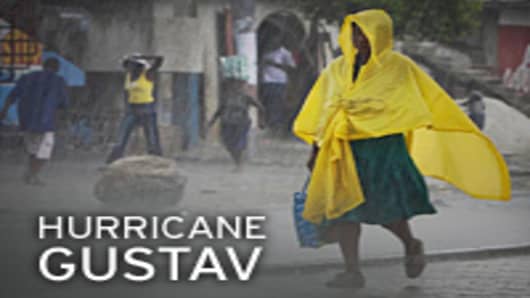New Orleans was still squarely in the storm's sights. The most likely long-range track forecast had it going ashore west of the city on Tuesday morning as a Category 3 storm on the five-stage Saffir-Simpson scale of hurricane intensity.
Oil prices climbed in the face of Gustav's threat to the 4,000 Gulf platforms that produce a quarter of U.S. oil and 15 percent of its natural gas. Energy companies evacuated offshore workers and shut production in preparation for the most serious storm since the devastating 2005 Atlantic hurricane season.
"The cyclone will have more than 24 hours over the very warm waters of the northwestern Caribbean... so strengthening seems imminent and could even be rapid," the U.S. National Hurricane Center said.
The Miami-based hurricane center said Gustav strengthened back into a Category 1 hurricane as it neared the wealthy Cayman Islands on Friday and could grow into at least a Category 3 storm before reaching western Cuba on Saturday.
By midafternoon, Gustav was 125 miles east-southeast of Grand Cayman Island and was moving west-northwest at 11 mph.
Its top sustained winds had strengthened to 75 mph and were projected to rise to 120 mph within 72 hours.
Katrina was a monstrous Category 5 hurricane in the Gulf of Mexico before coming ashore near New Orleans as a Category 3 on Aug. 29, 2005, breaching protective levees and flooding the city famed as the birthplace of jazz.
The devastation exposed deep poverty, racial tensions and federal incompetence as thousands of people were left stranded without aid. About 1,500 people were killed on the U.S. Gulf Coast and $80 billion in damages made Katrina the costliest U.S. natural disaster.
Katrina and Hurricane Rita, which followed in its wake, also wrecked more than 100 oil rigs.
In New Orleans, officials paused their Gustav preparations to mark the anniversary with a symbolic burial for more than 80 victims still unidentified three years after the storm.
This time, Louisiana authorities warned residents to prepare to evacuate as Gustav nears and laid on transport for those who do not have cars. Federal officials say the levees are stronger but gaps still exist that make vulnerable some of the neighborhoods hardest hit by Katrina's floods.
Gustav was expected to come ashore as President George W. Bush's Republican Party holds its convention to select Sen. John McCain as its nominee for the November presidential election.
Mounting Toll
Gustav barged into Haiti as a hurricane on Tuesday and killed at least 59 people there, eight in the neighboring Dominican Republic and five in Jamaica.


